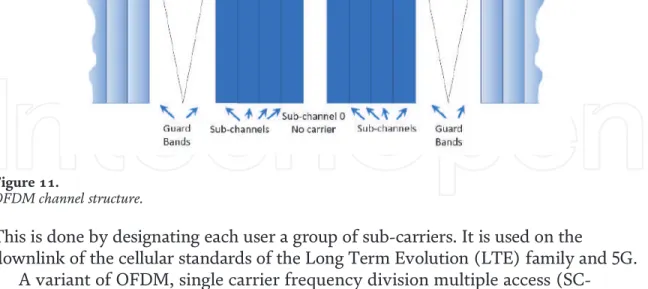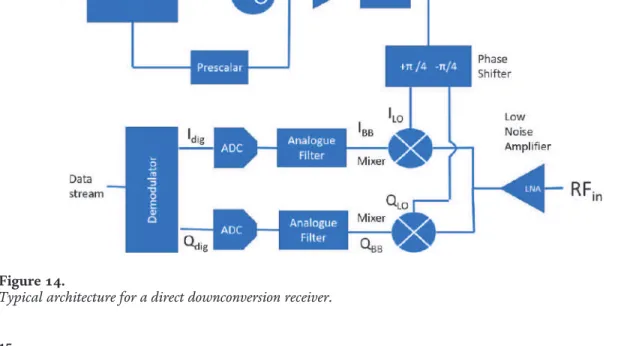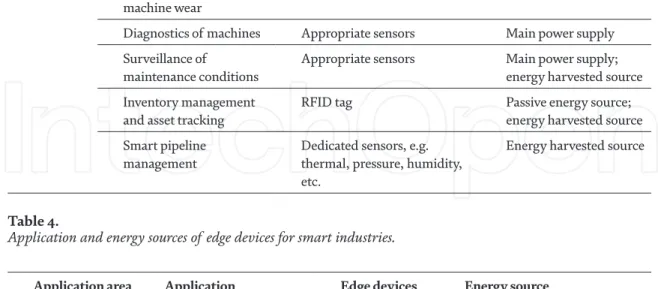We will focus primarily on three of the largest applications of machine learning (ML) in the medical and biomedical fields. The most common method for building machine learning models is to divide the data set into approximately 80% for training and 20% for testing.
Big data and the health information explosion
During cross-validation, this division into separate sections of the data occurs to ensure correct coverage. The average performance of these 10 models provides a good measure of the generalized performance of the algorithm on that type of data.
Machine learning of medical images
Lesion detection and computer automated detection
Example of mammography, where the left hand image is the image of a raw mammogram and the right hand is the image with the detection overlaid with the region of interest in white, using NASA software originally used to enhance geoscience images. These methods are primarily used to improve the accuracy of diagnosis and improve early diagnosis in the clinical setting.
Natural language processing of medical documents and literature Electronic medical records (EMR), the new standard in many hospitals, require
Examples of natural language processing in healthcare research
This is by no means an expansive list, but highlights the broad spectrum of possible machine learning applications. This method analyzed pathology reports and diagnosis codes to identify cancer patients using supervised machine learning.
Machine learning in genetics for the prediction and understanding of complex diseases
Inherited vs. environmental risk
Inherited risk describes mutations that exist in the human germline and will be passed on to offspring through normal reproduction. SNPs are a single or point mutation of one base pair in the human genome that occurs in at least 1% of the human population [ 83 , 84 ].
Prediction of cancers through germline copy number variations
Conclusions
The examples discussed in this chapter are some of the most promising work in the application of machine learning in healthcare. Efficient identification of nationally prescribed notifiable cancer cases using natural language processing and machine learning.
TOP 1%
Introduction
There is also a trade-off between cost and bandwidth: high bit rate solutions require large bandwidth which generally costs more than the low bandwidth. Finally, there is the often overlooked fact that high bit rate solutions require high fidelity from the radio, which means more reception power. If low cost, high bit rate wireless communication is not available, what are the alternatives if the sensor needs high bandwidth (video cameras are the most obvious example).
By processing the signal at the source - computers at the edge - we can reduce the bandwidth requirement, and so we can use an alternative wireless.
Review of digital communications systems
- Introduction
- Complex signals
- Encryption
- Interleaving
- Error coding and correction
- Modulation
- Channel access method
- Orthogonal frequency division multiplexing
- Half- and full-duplex
Along with all the other parts of the data transmission system, there is a need for data encryption. Interleaving is like shuffling a packet in an example; however, this is done in a controlled manner so that the data can be reconstructed. Adding error correction codes adds extra data to the transmission, reducing the overall energy efficiency of the system.
A filter must be used to band-limit the data, but the performance of the filter is important.
Overview of radio transmit and receive architectures
How a radio system handles the relationship between transmit and receive has a major impact on the design of the radio front end and the power consumption of the overall radio. In the case of the Cartesian transmitter, the signal path adds a significant amount of noise to the signal being transmitted. There are no pull problems as such in the receiver, so the VCO for the LO can be at the same frequency as the receive signal, but running at two or four times the frequency makes the generation of the quadrature components easier by a split VCO to use.
On the receive side, as on the transmit side, most of the power consumption occurs in the RF blocks.
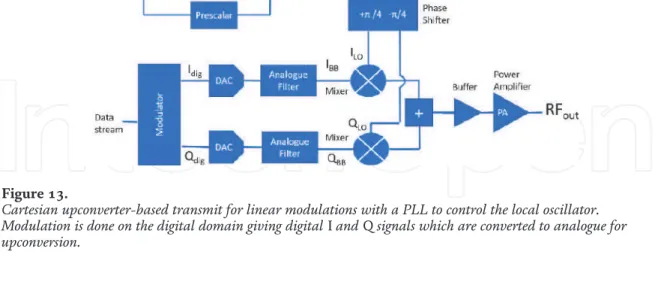
Trade-offs in radio systems for communications
- Frequency of the transmitter and receiver
- Bandwidth of the signal
- Number of radio bands supported
- Type of modulation: linear or non-linear
- Type of modulation: dynamic range required
- Full-duplex or half-duplex
- Transmit output power
- Presence of interfering signals
On the receiving side, the same type of RF receiver and analog circuits are used for both linear and non-linear modulation, so there is no difference between these types of modulation. A full-duplex radio offers the possibility of higher bit rates when transmitting and receiving because both are operating at the same time. This loss must be compensated by a lower noise figure in the receiver circuits, which requires more current.
To increase the dynamic range, it is necessary to increase the current in the circuits.
Overview of cellular radio systems
- Introduction
- GSM/GPRS
- Edge
- The UMTS: 3G system
- LTE: popularly known as 4G
- LTE-M
A further improvement was later added in Release 7 of the 3GPP specification and was known as Enhanced High Speed Packet Access (HSPA+), which used up to 64 QAM modulation and promised theoretical speeds of 337 Mbps downlink and 34 Mbps uplink. The maximum supported data rates in the latest version of the specification are 127 kbps downlink and 159 kbps uplink; as always, real-world data speeds are significantly lower than this. The 180 kHz usable bandwidth in the downlink must be compatible with LTE and thus uses OFDM with a maximum of 12 of the 15 kHz subcarriers.
To approach data rates in the Gbps range, it is necessary for the transmitter and receiver to be relatively close.
Overview of other radio systems
- Bluetooth low energy
- Zigbee
- LoRaWAN
- Sigfox
- Combining radio systems
Furthermore, one of the benefits of Bluetooth - the fact that its communications can penetrate walls - is also a vulnerability, as it can mean that the Bluetooth network can be accessed from outside the building. The Zigbee standard was developed by the Zigbee Alliance, but the physical (PHY – lowest layer) and medium access control (MAC) layers are taken from the Institute of Electrical and Electronics Engineers (IEEE) specification 802.15.4 [12]. Unfortunately, WiFi HaLow offers some advantages - the ability to increase data rates over a wide range is a useful feature - not many companies have adopted the standard, and no major companies produce chipsets that support it.
Since the communication bandwidth is narrow, the available data rate is small - 100–600 bits per second.
Radio for sensing: introduction to radar sensors
- FMCW principles of operation
- Moving to a 4D system
- FMCW signal processing
- FMCW radar and video
- Remote monitoring
- Heart beat and breathing
- Gesture
- Gait
With a single antenna, we have the distance to the target and the speed of the target relative to the antenna. This configuration can be used to obtain a complete 4D image of the environment ahead of the radar. This gives us the spectrum of the signal, where individual peaks will represent the object and the frequency associated with that peak can be used to calculate the distance to the object.
With dedicated hardware blocks to perform most of the processing required for radar and general use.
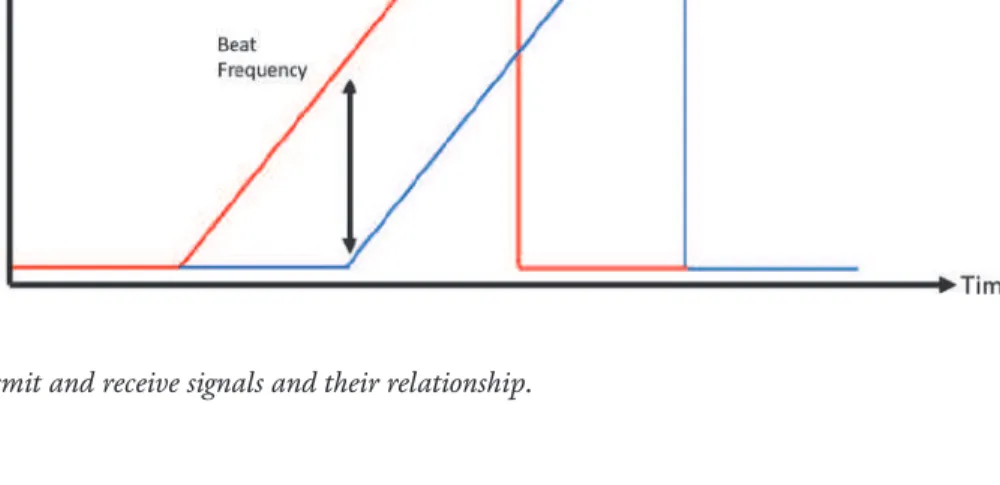
IoT, radios, and edge computing
- IoT sensor systems and radio requirements
- Bandwidth, bitrate, latency, and distance
In fact, the simplest sensor nodes that transmit data continuously do not even need a receiver. In an IoT system with a fixed position of sensor nodes, there is no need to support overheads in the radio system for mobile clients. It should be much more robust, as it wouldn't be able to make much use of ARQ without a significant bandwidth overhead.
If the answer is really no, you'll need to consider moving your computer closer to the camera.
Conclusions
If you are transmitting at full power, the only way to get more SNR is to move the transmitter closer to the receiver (or vice versa). The low latency requirement forces you to move your computing to the edge because of the lag between the base station and the server. Finally, if low latency is needed in a 5G system, the computer should be as close to the base station as possible.
The integration of energy harvesting technologies with Internet of things (IoTs) leads to the automation of buildings and homes.
IoT and IoT edge devices
- Importance of edge technology
- Advantages of enabling edge computing for IoTs
- Industry benefits
Thus, edge computing ensures that data is processed where it is generated instead of sending the data to data centers for processing. Reduced data exposure and reduced network load: Real-time data handling from end-to-end devices with preprocessing and storage capabilities prevents data from passing across the network and improves offline capabilities by making applications independent of uninterrupted network connection. Reduced Latency: IoT edge computing devices optimize network performance by reducing the delay or latency parameter.
Secure communication: Since edge computing architecture deals with the distributed nature of collecting, processing and storing data among the large variety of data centers and edge devices, it is not easy for an intruder to destroy the privacy and security of the network [9 ] .
Energy harvesting technology
Cloud-based deployments of edge devices and edge-to-cloud data exchange capabilities are the next generation built for 5G communications by telecom sector. High-speed network response with very low latency is the goal, with data compilation performed at the edge devices and reports sent to the central cloud for storage.
Requirement for energy harvesting in IoT
- Power
- Size scaling
- Cost factor
With the advancement in integrated circuit technology, the size of IoT devices is not an issue as a number of features can be integrated on a single chip. As an alternative to fixed charge batteries, the size of the energy storage unit is application specific and should not be larger than previous energy storage. The scalability of the energy harvesting unit with the size of the IoT module should be ideal.
Conventional battery is an economical product due to the mass production which leads to cost sensitive production of battery powered IoT devices.
Constraints and potentials of energy harvesting technique 1 Constraints
- Potentials
The battery used in conventional module designs generally has a life cycle of 1 year and is the main factor in the overall weight and size of the module. On the other hand, integrating the energy harvesting technique into the module will increase the cost. This cost will include the component cost along with the device redevelopment cost, because implanting an energy harvesting device on top of the conventional module is not a practical solution and the entire internal design is modified.
With the growth of the IoT industry, more energy harvesting modules will be implemented which in turn will reduce the cost.
Energy harvesting standards
- Socio-economic applications
Energy harvesting technology has been increasingly used in the defense sector as it leads the way in which heavy battery packs are replaced by autonomous or rechargeable devices. According to the latest study, energy harvesting-based defense applications are targeting 730 million EUR in table 4). Energy harvesting will be an essential element for the upcoming trend of home automation and smart homes.
Rapid growth of IoT devices is also possible with energy harvesting as it facilitates rechargeable power supply with low installation and maintenance costs.
Communication protocols used in IoT systems
Summary
Several practical implementations of energy harvesters have been surveyed in the literature that provide power to drive IoT devices. But there are various technical limitations that limit the worldwide implementation of energy harvesting technology. Light or thermal energy harvesting source Network connected sensors Smart main power supply.
Edge of things: The big picture of integrating the edge, the Internet of Things, and the cloud into a distributed computing environment.
